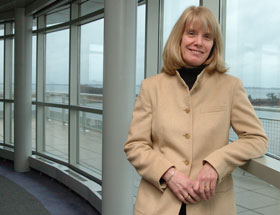  |
| HOME | THIS ISSUE | CALENDAR | GRANTS | BACK ISSUES | < BACK | NEXT > |
Zooplankton expert is new head of marine sciences departmentby Cindy Weiss - February 13, 2006 |
||||
|
Ann Bucklin came to UConn six months ago from the University of New Hampshire to head the marine sciences department in the College of Liberal Arts and Sciences with impressive credentials. A former professor of zoology at the University of New Hampshire, she was director of its Sea Grant program, founding director of its federally funded Northeast Consortium for research collaborations between scientists and fisheries, and the U.S. academic delegate to the International Council for the Exploration of the Sea (ICES). But she had never been a department head. “This is a brand new kind of job for me,” she said, during an interview in her Avery Point office. “My worst fear was that I would make no difference.” She hopes to move the department toward new ways of doing things. After a retreat in November, the department emerged with new ad hoc committees to evaluate its graduate curriculum, how it serves undergraduates, and how it can recruit and retain top graduate students. “It’s a very hardworking faculty,” says Bucklin. “It’s a very can-do, will-do department.” Marine sciences is also the top-ranked department in the Graduate School for research expenditures per faculty member, with more than $13.5 million in active grants. The department has 16 tenured or tenure-track faculty, four research faculty, and 48 graduate students. It also has 75 undergraduate majors, and plans to expand to 100. Housed in the Marine Sciences Building, it now offers “a full spectrum of oceanography,” Bucklin says, with five new faculty hired this year. That growth was made possible by special funding and partnerships, including support from the Avery Point campus, where marine sciences faculty often teach introductory science courses. The department’s focus is on “green water oceanography,” or coastal environmental systems, with a number of people specializing in marine biology. UConn’s department is interdisciplinary. Faculty bring expertise in biology, chemistry, geology, meteorology, and physics to the study of topics such as water chemistry, the physics of ocean waves, and biological processes and organisms. Bucklin hopes to work with fishermen, coastal developers, and recreational boaters to make the department’s work relevant to them. She’s particularly interested in “fishing smarter,” or finding ways to fish commercially that are targeted to particular species. Bucklin’s own research interests are molecular ecology, population genetics, and systematics, or how ocean systems function. She is director of the zooplankton section of the international Census of Marine Life, which will complete a global survey by 2010 of the number of species of zooplankton, where they live, and how many individuals are in each species.
The purpose of the project, which began with funding and workshops sponsored by the Alfred P. Sloan Foundation, is to understand marine biodiversity. While the census first counted what Bucklin calls “charismatic megafauna,” such as whales and dolphins, her proposal in 2004 extended it to the less charismatic zooplankton, the tiny creatures that are often whale food. She enlisted co-principal investigators from Japan and Germany to scour the deep water of the oceans around the world for the project. She also heads a 20-person steering group of zooplankton specialists and scientists from 16 countries. The project makes use of a range of ships going to sea – including commercial and sailing vessels – to collect samples. By 2010, the scientists hope to have DNA-barcoded – or identified through a common DNA sequence – 8,000 described zooplankton in 15 phyla. Bucklin expects to find at least as many new species. “There are a lot of animals down there that no one has ever seen,” she says. Bucklin’s interest in marine science was piqued by a professor she studied with as an undergraduate at Oberlin College, close to Lake Erie but far from the ocean. At the University of California at Berkeley, where she earned her Ph.D., she began as a marine biologist, studying sea anemones, and left as an oceanographer, interested in ocean dynamics. Her husband, Peter Wiebe, is a senior scientist at Woods Hole Oceanographic Institute in Massachusetts, where Bucklin was a postdoctoral fellow. She and Wiebe collaborate on research cruises with other oceanographers, capturing data with instruments Wiebe designs. They both conduct research in Norway, where Bucklin had a Fulbright grant to study population genetics in the fjords. Moving to Mystic from New Hampshire was a homecoming for Bucklin, who spent summers in coastal Connecticut with her grandparents as a child. As the first woman to head the marine sciences department, Bucklin says she is familiar with the sentiment that women are appointed only because of their gender: “My comment is always, ‘first you get the job, and then you earn it’.” |
| ADVANCE HOME UCONN HOME |

